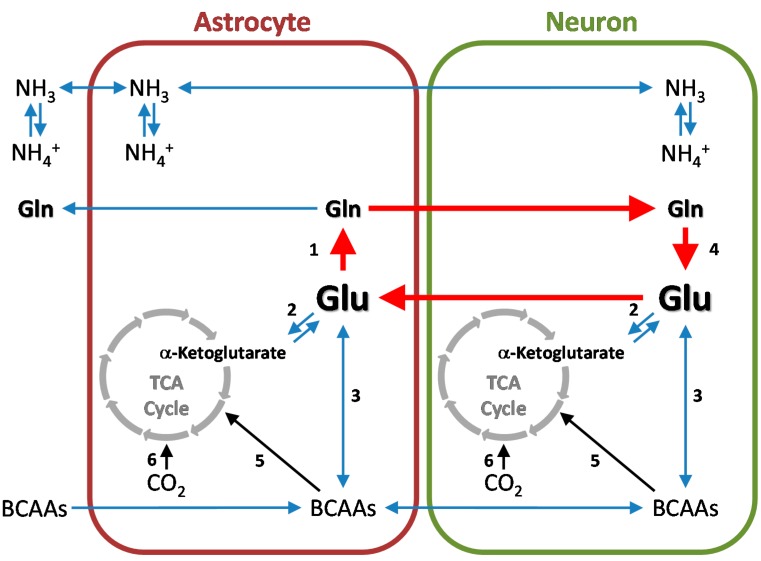Figure 4.
Cerebral glutamine cycle and ancillary reactions. Under normal conditions ammonia enters the brain mostly by diffusion of the free base (NH3) [90]. This ammonia, and that derived from endogenous reactions, is metabolized primarily via incorporation into the amide position of L-glutamine in a reaction catalyzed by astrocytic glutamine synthetase (reaction 1). Although the GDH reaction is freely reversible, this enzyme is a net source of ammonia (reaction 2) rather than a net remover of ammonia. The glutamate required for glutamine synthesis in the astrocytes is derived in part from glutamate released from neurons during neurotransmission; the nitrogen of this glutamate may be obtained by transamination of α-ketoglutarate with suitable amino acids (e.g., branched-chain amino acids, BCAAs) (reaction 3). Some of the glutamine formed in the glutamine synthetase reaction may be released to the circulation to maintain nitrogen and carbon homeostasis. Another portion may be returned to the neurons, wherein it is converted back to glutamate by the action of glutaminase(s) (reaction 4). The sequence Glu (neurons) → Glu (astrocytes) → Gln (astrocytes) → Gln (neurons) → Glu (neurons) constitutes the cerebral glutamine cycle. As discussed in the text anaplerotic reactions occur in the brain and may be used to replenish 5-C units. Such anaplerotic reactions include CO2 fixation by pyruvate carboxylase (→, reaction 6) and metabolism in part of branched-chain amino acids (→, reaction 5). For simplicity the glutamine-GABA cycle is not shown. Although ammonia produced in neurons is kinetically distinct from that produced in astrocytes, this ammonia must eventually enter the astrocytes wherein it is a substrate of glutamine synthetase. This is accomplished by diffusion of the free base (NH3) or by ammonium (NH4+) transporters [133].

